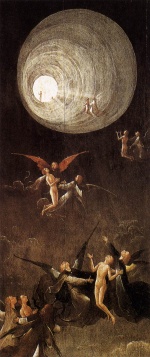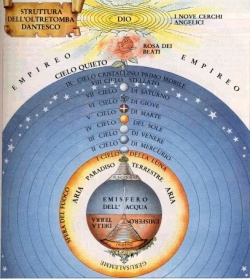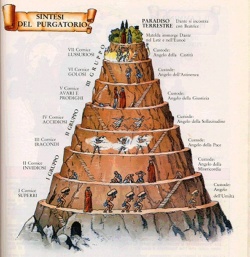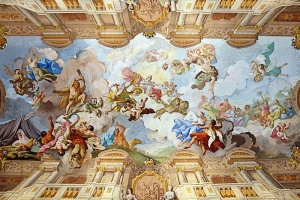Vida después de la muerte
Vida después de la Muerte
De acuerdo con las enseñanzas Teosóficas después de la muerte del cuerpo, la consciencia experimenta una serie de transformaciones. Las tendencias, emociones, pensamientos, memorias, y aspiraciones que fueron parte de la personalidad son clasificadas. Cualquier cosa que perteneciera al aspecto completamente personal y egoísta es descartado, en tanto que todo lo que fue de naturaleza generosa y altruista es preservada y asimilada por el alma humana. En los escritos de H.P. Blavatsky y los Maestros de Sabiduría la descripción más frecuente de los diferentes estados después de la muerte física incluye: a) la "lucha a muerte", b) periodo de gestación, c) Devachan, y d) Reencarnación.
Descripción general
En la visión de la Teosofía, la muerte no es el fin de la experiencia consciente, sino, por el contrario, es el comienzo de una consciencia más amplia.H. P. Blavatsky dijo:
Nosotros aceptamos la consciencia después de la muerte, y dice que la real consciencia y la real libertad del Ego o del alma comienza solo después de la muerte física del hombre. Es entonces que ya no es impedido con asuntos terrestres y que es libre, que puede percibir todo.[1]
Lo que se conoce como "muerte" implica la salida de principio vital y la disolución del cuerpo físico junto con su doble astral de materia etérica. Después de esto, viene un periodo de disolución del Alma animal y el aspecto personal del alma humana en Kāmaloka. Finalmente, el aspecto espiritual del alma humana es asimilada por el [[alma|alma espiritual] en Devachan. En las palabras de Mme. Blavatsky's:
Siendo Alma un término genérico, hay en el hombre tres aspectos del Alma - la terrenal o animal; el alma Humana; y el Alma Espiritual; éstas, estrictamente hablando, son un alma en sus tres aspectos. Ahora del primer aspecto nada queda después de la muerte; del segundo (nous o Manas) solo su esencia divina, si quedó sin manchas sobrevive, mientras que la tercera en adición por ser inmortal se vuelve conscientemente divina, por la asimilación del Manas superior.[2]
El alma espiritual o Buddhi es de naturaleza universal y, por si misma, carece del elemento de auto-conciencia. Después de la muerte puede volverse consciente de su propia naturaleza divina por la asimilación de los elementos espirituales de la consciencia mental, si la persona alguna vez ejercitó este aspecto de la mente.
Se han descrito las diferentes etapas por el Maestro Koot Hoomi en una de sus cartas como sigue:
El periodo entre la muerte y el renacimiento . . . puede durar desde unos pocos años a un kalpa. Esta dividido en tres sub-periodos (1) cuando el Ego libre de su envoltura mortal entra en Kama-Loka (la morada de los Elementarios); (2)cuando entra en su "Estado de Gestación"; (3) cuando es renacido en el Rupa-Loka el Deva-Chan. Sub-periodo (1) puede durar desde unos pocos minutos a varios años — la frase "unos pocos años" puede volverse desconcertante y totalmente inútil sin una explicación más completa; Sub-periodo (2) es "muy largo"; como tu dices, más largo a veces de lo que te puedas imaginar, pero proporcional a la resistencia espiritual del Ego; Sub-periodo (3) demora en proporción al buen KARMA, después del cual la monada es nuevamente reencarnada.[3]
La "Lucha de muerte"
Después de la eliminación de los tres principios inferiores de la consciencia que ocurre durante la muerte física, los cuatro principios restantes entran en Kāmaloka, la cual es una esfera intermedia entre la física y la espiritual. Antes de que la consciencia pueda pasar al devachan, es necesaria
una "purificación" de los elementos físicos. Como H. P. Blavatsky escribió:
Cuando la monada espiritual esforzándose para entrar en el estado Devachánico está siendo sometido a un proceso de purificación, lo que sucede es lo siguiente: la consciencia personal, que sólo constituye el Ego personal, se tiene que desprender de si misma de toda mancha terrenal de materia grosera antes de que sea capaz de vivir "en espíritu" y como un espíritu.[4]
Kama-loka puede ser comparado con el camarín de un actor, en el cual el se despoja de su traje de la última parte en la que actuó antes de volver a convertirse a sí mimo precisamente - el inmortal Ego o el ciclo de Peregrinaje en esta Ronda de Encarnaciones. El Ego Eterno [es] despojado en Kama-loka de sus principios terrestres inferiores, con sus pasiones y deseos. . . . Pero el proceso de despojarse de lo más inferior, los principios cuarto y parte del quinto, es inconsciente en todos los seres humanos normales. Es solo en casos muy excepcionales que hay un leve retorno a la consciencia en Kama-loka: y este es el caso de una personalidad materialista y no espiritual, quien, desprovisto de las condiciones requeridas, no pueden entrar en el estado de absoluto Reposo y Bienaventuranza.
Durante este periodo hay una tensión entre los dos principios inferiores, que posee una tendencia hacia la materialidad, y los dos más elevados, que son de naturaleza espiritual. Lo que sucede puede ser visto metafóricamente como una "lucha" entre los aspectos animales y espirituales del alma (Kāma y Buddhi respectivamente) para asimilar Manas. En one of his letters, Master K.H. explicó el proceso como sigue:
Cuando el hombre muere sus principios segundo y tercero mueren con el; la triada inferior desaparece, y los principios cuarto, quinto, sexto y séptimo forman el Quaternario sobreviviente. . . . . De allí en adelante una luche "muerte" entre las dualidades Superior e Inferior. Si gana la superior, la sexta, habiendo atraído a hacia sí mismo la quinta esencia del Bien de la quinta - sus afecciones nobles, sus aspiraciones santas (aunque sean terrenales), y las porciones mas Espiritualizadas de su mente - sigue su mayor divinidadr (la séptima) al estado de "Gestación"; y la quinta y la cuarta permanecen en asociación como un kamaloka#cascarón vacío . . . para vagar en la atmósfera terrenal, con la mitad de la memoria personal perdida, y los instintos brutales completamente vivos por un cierto periodo.[5]
Después de la lucha a muerte los dos principios más elevados, junto con la esencia espiritual de manas, entran en un periodo de gestación. Mientras que, el cuarto principio (Kāma), con cualquier elemento personal y egoísta que pueda retener del principio manásico, forma una concha y permanece en Kāmaloka para ser eventualmente disuelto. Sin embargo, puede suceder que la duada superior no logre asimilar ninguna esencia espiritual de la inferior. En tal caso esa vida personal particular es completamente inútil para la Monada, y es "borrada" de sus registros. Como el Maestro continuó diciendo:
Si, por otro lado, la Dualidad Superior es vencida, entonces es el quinto principio que asimila todo lo que pueda haber quedado de la recolección y percepciones personales de su individualidad personal en el sexto . . . . Los [principios] sextos y séptimos — ahora una MONADA puramente espiritual, individual, con nada que quede en ella de la reciente personalidad, no quedando ningún periodo regular de "gestación" para atravesar (debido a que no hay ningún Ego personal purificado para renacer), después de un periodo más o menos prolongado del Resto inconsciente en el Espacio infinito - se encontrará renacido en otra personalidad en el próximo planeta. Cuando llega el periodo de “Completa Consciencia Individual" — la que precede a aquella de Absoluta Consciencia en el Pari-Nirvana — esta vida personal perdida llega a ser como una página arrancada del gran Libro de las Vidas, incluso sin una palabra desconectada restante para marcar su ausencia. La monada purificada no percibirá ni recordará las series de sus renacimientos pasados - la que se habría ido al "Mundo de las Formas" (rupa-loka) — y su mirada retrospectiva ni siquiera percibirá la más leve señal para indicar que hubiera existido.[6]
In this case, the discarded personal elements do not become a regular "shell" to be dissolved in Kāmaloka. With the additional consciousnes
The "Death struggle"
After the disposal of the three lower principles of consciousness that happen during physical death, the four principles remaining enter in Kāmaloka, which is an intermediate sphere between the physical and the spiritual. Before consciousness can pass on to devachan, a "purification" of the psychic elements is necessary. As H. P. Blavatsky wrote:
When the spiritual monad striving to enter the Devachanic state is being subjected to the process of purification, what happens is this: personal consciousness, which alone constitutes the personal Ego, has to rid itself of every earthly speck of grossly material taint before it becomes capable of living “in spirit” and as a spirit.[7]
Kama-loka may be compared to the dressing-room of an actor, in which he divests himself of the costume of the last part he played before rebecoming himself properly - the immortal Ego or the Pilgrim cycling in his Round of Incarnations. The Eternal Ego [is] stripped in Kama-loka of its lower terrestrial principles, with their passions and desires. . . . But the process of stripping off the lower, the fourth and part of the fifth, principles is an unconscious one in all normal human beings. It is only in very exceptional cases that there is a slight return to consciousness in Kama-loka: and this is the case of very materialistic unspiritual personalities, who, devoid of the conditions requisite, cannot enter the state of absolute Rest and Bliss.[8]
During this period there is a tension between the two lower principles, which possess a tendency towards materiality, and the two higher, which are of a spiritual nature. What happens can be metaphorically seen as a "struggle" between the animal and the spiritual aspects of the soul (Kāma and Buddhi respectively) to assimilate Manas. In one of his letters, Master K.H. explained the process as follows:
When man dies his second and third principles die with him; the lower triad disappears, and the fourth, fifth, sixth and seventh principles form the surviving Quaternary. . . . Thenceforth it is a "death" struggle between the Upper and Lower dualities. If the upper wins, the sixth, having attracted to itself the quintessence of Good from the fifth — its nobler affections, its saintly (though they be earthly) aspirations, and the most Spiritualised portions of its mind — follows its divine elder (the 7th) into the "Gestation" State; and the fifth and fourth remain in association as an empty shell . . . to roam in the earth's atmosphere, with half the personal memory gone, and the more brutal instincts fully alive for a certain period.[9]
After the death struggle the two higher principles, along with the spiritual essence of manas, enter into a period of gestation. Meanwhile, the fourth principle (Kāma), with whatever personal and selfish element it could retain from the manasic principle, forms a shell and stays in Kāmaloka to be eventually dissolved. However, it may happen that the upper duad does not succeed in assimilating any spiritual essence from the lower one. In such a case that particular personal life is completely useless to the Monad, and is "erased" from its records. As the Master continued saying:
If, on the other hand, it is the Upper Duality which is defeated, then it is the fifth principle that assimilates all that there may be left of personal recollection and perceptions of its personal individuality in the sixth. . . . The sixth and seventh [principles] — now a purely spiritual, individual MONAD, with nothing left in it of the late personality, having no regular “gestation” period to pass through (since there is no purified personal Ego to be reborn), after a more or less prolonged period of unconscious Rest in the boundless Space — will find itself reborn in another personality on the next planet. When arrives the period of “Full Individual Consciousness” — which precedes that of Absolute Consciousness in the Pari-Nirvana — this lost personal life becomes as a torn out page in the great Book of Lives, without even a disconnected word left to mark its absence. The purified monad will neither perceive nor remember it in the series of its past rebirths — which it would had it gone to the “World of Forms” (rupa-loka) — and its retrospective glance will not perceive even the slightest sign to indicate that it had been.[10]
In this case, the discarded personal elements do not become a regular "shell" to be dissolved in Kāmaloka. With the additional consciousness gained by retaining all the manasic elements used in that incarnation, it has enough cohesion to be reincarnated as a soul-less entity on earth. This state is called Avichi (see below).
Period of gestation
In most cases the upper duad finds some spiritual elements that allows it to be "born" in Devachan. But before this is possible the soul has to undergo a period of spiritual gestation. A. P. Sinnett wrote:
When the division of, or purification of the fifth principle has been accomplished in Kama loca by the contending attractions of the fourth and sixth principles, the real Ego passes into a period of unconscious gestation . . . a spiritual ante-natal state at the entrance to spiritual life . . . and this period, in different cases, may be of very different duration--from a few moments to immense periods of years.[11]
According to H. P. Blavatsky the gestation period "lasts from a few days to several years",[12] while Mahatma K.H. wrote that it can be very long: "longer sometimes than you may even imagine, yet proportionate to the Ego's spiritual stamina".[13]
It is usually said that the reviving of consciousness begins at the door of Devachan, once the struggle in Kama-Loka is over, but only after the period of gestation:[14]
That remembrance will return slowly and gradually toward the end of the gestation (to the entity or Ego), still more slowly but far more imperfectly and incompletely to the shell, and fully to the Ego at the moment of its entrance into the Devachan.[15]
However, there are some statements that indicate the possibility of consciousness before Devachan (see below).
In this case, the discarded personal elements do not become a regular "shell" to be dissolved in Kāmaloka. With the additional consciousness gained by retaining all the manasic elements used in that incarnation, it has enough cohesion to be reincarnated as a soul-less entity on earth. This state is called Avichi (see below).
Period of gestation
In most cases the upper duad finds some spiritual elements that allows it to be "born" in Devachan. But before this is possible the soul has to undergo a period of spiritual gestation. A. P. Sinnett wrote:
When the division of, or purification of the fifth principle has been accomplished in Kama loca by the contending attractions of the fourth and sixth principles, the real Ego passes into a period of unconscious gestation . . . a spiritual ante-natal state at the entrance to spiritual life . . . and this period, in different cases, may be of very different duration--from a few moments to immense periods of years.[16]
According to H. P. Blavatsky the gestation period "lasts from a few days to several years",[17] while Mahatma K.H. wrote that it can be very long: "longer sometimes than you may even imagine, yet proportionate to the Ego's spiritual stamina".[18]
It is usually said that the reviving of consciousness begins at the door of Devachan, once the struggle in Kama-Loka is over, but only after the period of gestation:[19]
That remembrance will return slowly and gradually toward the end of the gestation (to the entity or Ego), still more slowly but far more imperfectly and incompletely to the shell, and fully to the Ego at the moment of its entrance into the Devachan.[20]
However, there are some statements that indicate the possibility of consciousness before Devachan (see below).
Regarding the total time elapsed by a normal person in Kāmaloka (that is, during the death struggle and the period of gestation), Mme. Blavatsky wrote:
The normal period during which any part of the consciousness remains in Kâma-Loka, i.e., is connected with the Kâma-Rûpa, is one hundred and fifty years. The Kâma-Rûpa eventually breaks up, and leaving in Kâma-Loka the Tânhic Elementals, its remaining portions go into animals.[21]
Read more
Devachan
After the period of gestation, the new "devachanic ego" (that is, the pure elements of the personal ego that have been assimilated to the two higher principles) begins to awaken in Devachan:
The Eternal Ego being stripped in Kama-loka of its lower terrestrial principles, with their passions and desires, it enters into the state of Devachan. And therefore it is said that only the purely spiritual, the non-material emotions, affections and aspirations accompany the Ego into that state of Bliss.[22]
In one of his letters, Master K.H. wrote:
"Who goes to Deva Chan?" The personal Ego of course, but beatified, purified, holy. Every Ego - the combination of the sixth and seventh principles - which after the period of unconscious gestation is reborn into the Devachan, is of necessity as innocent and pure as a new-born babe. The fact of his being reborn [in Devachan] at all, shows the preponderance of good over evil in his old personality. And while the Karma (of evil) steps aside for the time being to follow him in his future earth-reincarnations, he brings along with him but the Karma of his good deeds, words, and thoughts, into this Devachan.[23]
In Devachan, the person enjoys the result of the good actions done in the life just finished, as well as receives a compensation for the unmerited suffering experienced:
Devachan is the idealized continuation of the terrestrial life just left behind, a period of retributive adjustment, and a reward for unmerited wrongs and sufferings undergone in that special Life.[24]
Reincarnation
When the period of Devachan is over, the higher ego begins the process of reincarnation. Before it is reborn, however, it sees the life about to be started in its general characteristics, as delineated by its Karma. Mme. Blavatsky wrote:
As the man at the moment of death has a retrospective insight into the life he has led, so, at the moment he is reborn on to earth, the Ego, awaking from the state of Devachan, has a prospective vision of the life which awaits him, and realizes all the causes that have led to it. He realizes them and sees futurity, because it is between Devachan and re-birth that the Ego regains his full manasic consciousness, and rebecomes for a short time the god he was, before, in compliance with Karmic law, he the total time elapsed by a normal person in Kāmaloka (that is, during the death struggle and the perio
- ↑ Michael Gomes (traductor), Comentarios de la Doctrina Secreta (The Hague: I.S.I.S. foundation, 2010), 44.
- ↑ Helena Petrovna Blavatsky, "La Clave de la Teosofía" (Pasadena, CA: Theosophical University Press, 1972), 121-122.
- ↑ Vicente Hao Chin, Jr., Cartas de los Mahatmas a A.P. Sinnett en secuencia cronológica No. 68 (Quezon City: Theosophical Publishing House, 1993), 194.
- ↑ Helena Petrovna Blavatsky, Collected Writings vol. VI (Wheaton, IL: Theosophical Publishing House, 1989), 328.
- ↑ Vicente Hao Chin, Jr., The Mahatma Letters to A.P. Sinnett in chronological sequence No. 68 (Quezon City: Theosophical Publishing House, 1993), 192-193.
- ↑ Vicente Hao Chin, Jr., The Mahatma Letters to A.P. Sinnett in chronological sequence No. 68 (Quezon City: Theosophical Publishing House, 1993), 193.
- ↑ Helena Petrovna Blavatsky, Collected Writings vol. VI (Wheaton, IL: Theosophical Publishing House, 1989), 328.
- ↑ Helena Petrovna Blavatsky, Collected Writings vol. IX (Wheaton, IL: Theosophical Publishing House, 1974), 164.
- ↑ Vicente Hao Chin, Jr., The Mahatma Letters to A.P. Sinnett in chronological sequence No. 68 (Quezon City: Theosophical Publishing House, 1993), 192-193.
- ↑ Vicente Hao Chin, Jr., The Mahatma Letters to A.P. Sinnett in chronological sequence No. 68 (Quezon City: Theosophical Publishing House, 1993), 193.
- ↑ Alfred Percy Sinnett, Esoteric Buddhism (San Diego, CA: Wizards Bookshelf, 1987), 96-97.
- ↑ Helena Petrovna Blavatsky, Collected Writings vol. IV (Wheaton, IL: Theosophical Publishing House, 1991), 120-121.
- ↑ Vicente Hao Chin, Jr., The Mahatma Letters to A.P. Sinnett in chronological sequence No. 68 (Quezon City: Theosophical Publishing House, 1993), 194.
- ↑ Vicente Hao Chin, Jr., The Mahatma Letters to A.P. Sinnett in chronological sequence No. 104 (Quezon City: Theosophical Publishing House, 1993), 362.
- ↑ Vicente Hao Chin, Jr., The Mahatma Letters to A.P. Sinnett in chronological sequence No. 104 (Quezon City: Theosophical Publishing House, 1993), 362.
- ↑ Alfred Percy Sinnett, Esoteric Buddhism (San Diego, CA: Wizards Bookshelf, 1987), 96-97.
- ↑ Helena Petrovna Blavatsky, Collected Writings vol. IV (Wheaton, IL: Theosophical Publishing House, 1991), 120-121.
- ↑ Vicente Hao Chin, Jr., The Mahatma Letters to A.P. Sinnett in chronological sequence No. 68 (Quezon City: Theosophical Publishing House, 1993), 194.
- ↑ Vicente Hao Chin, Jr., The Mahatma Letters to A.P. Sinnett in chronological sequence No. 104 (Quezon City: Theosophical Publishing House, 1993), 362.
- ↑ Vicente Hao Chin, Jr., The Mahatma Letters to A.P. Sinnett in chronological sequence No. 104 (Quezon City: Theosophical Publishing House, 1993), 362.
- ↑ Helena Petrovna Blavatsky, Collected Writings vol. XII (Wheaton, IL: Theosophical Publishing House, 1980), 708.
- ↑ Helena Petrovna Blavatsky, Collected Writings vol. IX (Wheaton, IL: Theosophical Publishing House, 1974), 164.
- ↑ Vicente Hao Chin, Jr., The Mahatma Letters to A.P. Sinnett in chronological sequence No. 68 (Quezon City: Theosophical Publishing House, 1993), 190.
- ↑ Helena Petrovna Blavatsky, The Key to Theosophy (London: Theosophical Publishing House, [1987]), 132.



